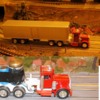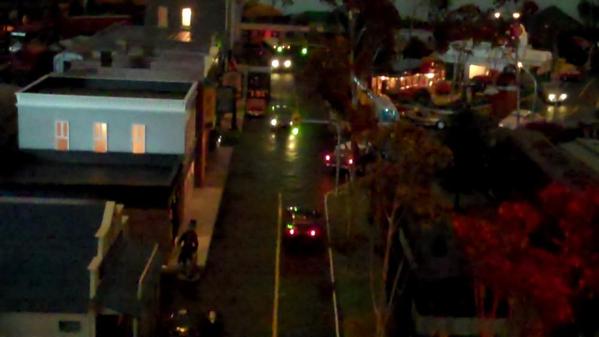After a week away on "vacation" and taking a day of "just running trains" yesterday, I got back in my workshop today and took up my "third generation" tractor trailer project. Generations 1 and 2 had numerous limitations due to their use of stock 'Streets chassis and motors, most noteably they did not smoothly a real low speeds and some signs of having only marginal power. This first gen-three tractor has both rear axles powered by a nice big can motor with a flywheel. Electrical pickup is through all ten wheels and five center pickups. As you can see, things are still beta rigged with tape and such as I work on weight distribution, pivot points, etc. The mass you see sitting right behind the motor is 30 pennies put there for weight and traction. I'm still experimenting with how much and where weight works best. But it's looking like a tractor trailer now and it runs better than any previous 18-wheeler.
In the video below you can hear some wheel chatter in the curve - I'll talk about that at the end. After the turn I slow it down along mainstreet. It will go slower but this is about as slow as I will ever run it. As you can see it runs very steadily at a an appropriately slow speed that an 18 wheeler would take doing through a downtown line this. Stock 'Streets vehicles won't.
I think a good test of the design, weight distribution, and pivot points of a tractor trailer is if and how it can back up. Here is the answer.
More: Initially, I am building two "third gen" tractor trailers, this one which is true-to-prototype by being powered by the tractor's duel rear axles, and one I expect to run much better: only one of the tractor's rear axles will be powered, but then one of the two at the rear of the tractor will be powered too (it will use two slightly smaller motors, one for each powered axle). I have not started that yet. I plan to finish this one completely first - it runs well and will, when done, look like a very good model. The wheel chatter is due to its spinning its wheels in curves - none of the four powered wheels has a traction tire and this puppy gets marginal traction even with considerable weight over the powered axles. I plan to coat the wheel face (but not flanges) of all four powered wheels with Frogsnot (yes, it will kill electrical conductivity of these wheels a lot, but there are six other wheels that also pick up power so there will be plenty of electrical contact.












